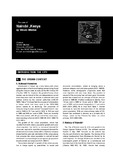| dc.description.abstract | Urbanisation in Kenya has a long history with urban
agglomeration in the form of trading centres being found
along the Kenyan coast as early as the 9th Century AD
(Obudho 1988: 3) . However, the growth of many urban
centres can be traced to the pre-independence period
when they were used as centres of administrative and
political control by the colonial authorities (UNCHS
1985). Table 1.0 shows that the process of urbanisation
in Kenya, which had been rapid in the 1979-1989
period, seems to be declining. The proportion of
Kenyans living in urban centres1 increased from 5.1 per
cent in 1948 to 15.1 per cent in 1979, to 18.0 per cent
in 1989 and 34.8 per cent in 2000. There are currently
194 urban centres, with 45 per cent of the urban population
residing in Nairobi (GOK 1996:35; GOK 1989:74;
GOK 2001).
The growth of the urban population, which has
resulted from both natural population growth and ruralurban
migration, has led to an increased demand for
resources required to meet the consequent demand for
infrastructure services (Olima 2001). Statistical analysis
shows that the rank size distribution of the urban places
that comprise this urban population is and will be well
distributed, corresponding to what regional geographers
would consider as balanced (GOK 1993:7)
The evident slowing2 of growth of the urban population
in Kenya opens up possibilities for social and economic consolidation, aimed at bringing about a
balance between rural and urban growth (GOK 1993:6).
However, while demographic projections show that
rural migration will also slow down, the position in
respect of the economy has not been good. Economic
growth has slowed from an average of 3.8 per cent per
annum in 1986-90. It further continued to decline, from
1.8 per cent in 1998 to 1.4 per cent in 1999, -0.2 per
cent in 2000 and increased marginally to 1.2 per cent in
2001 (GOK 2002). As is clear from Table 1, Nairobi
continues to have the dominant share of the national
urban population. With an urban primacy index of 2.6,
Nairobi has continued to develop as a primate city in
Kenya, based on the “Eleven-City Index” on urban
primacy (GOK 2002:236). | en |

